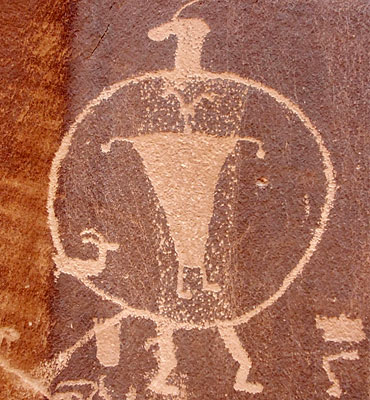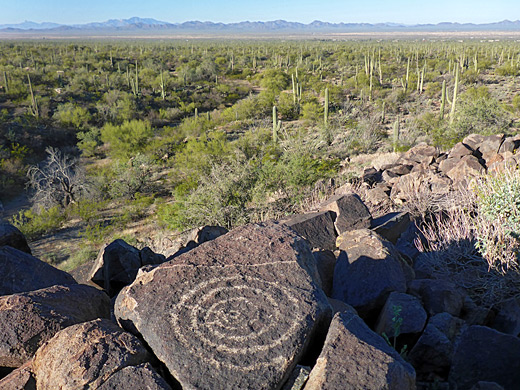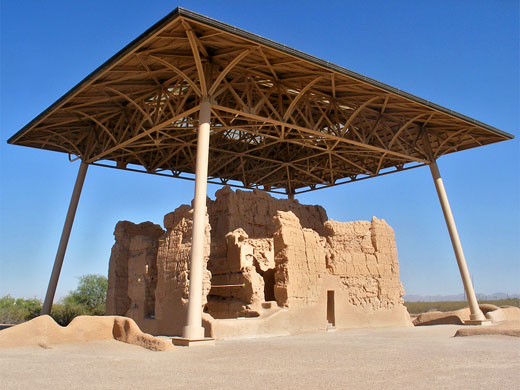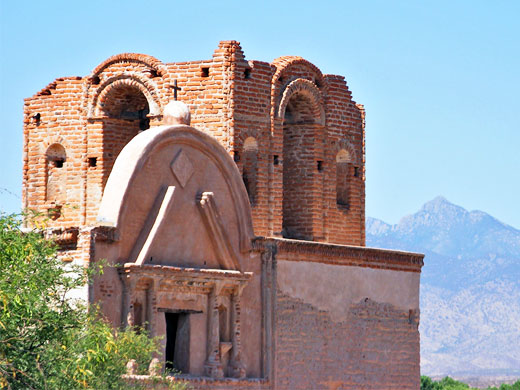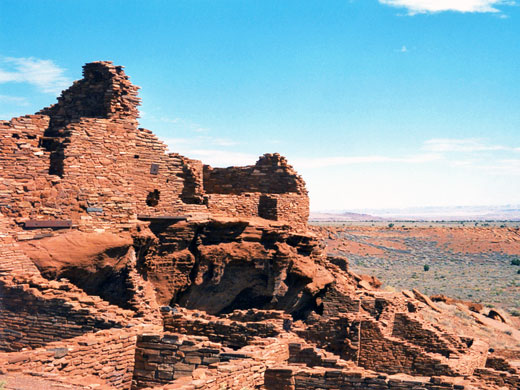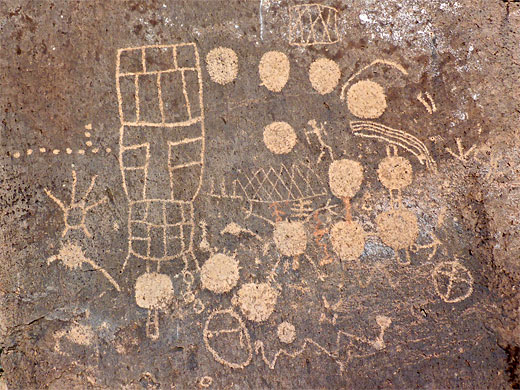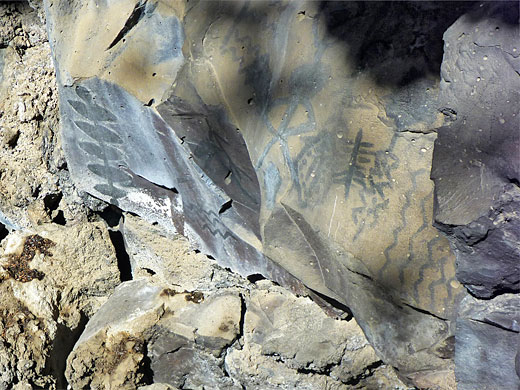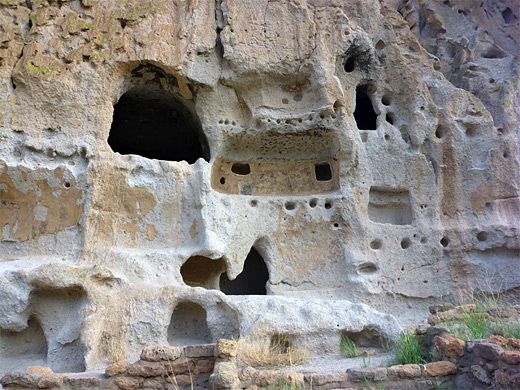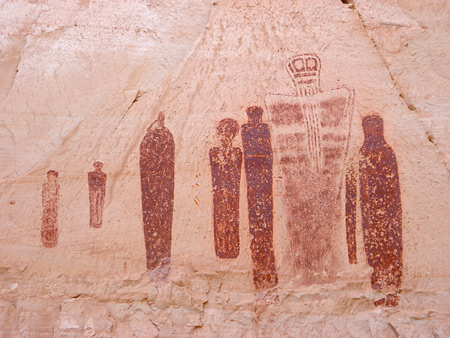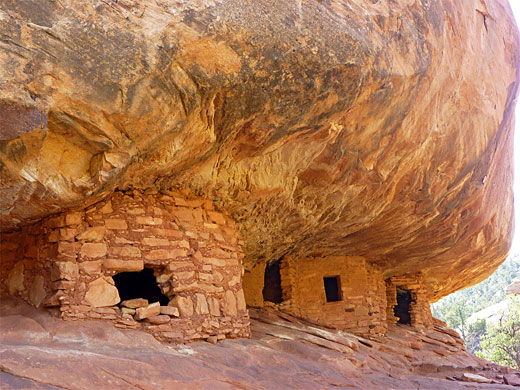Guidelines for visiting archaeological sites
All the Southwest states contain countless ancient remains, Native American sites and rock art panels but by far the most famous locations are found on the Colorado Plateau of northeast Arizona, southeast Utah, southwest Colorado and northwest New Mexico. Outside this region the only National Park Service property with prehistoric relics is Alibates Flint Quarries National Monument in the Texas Panhandle, a lightly visited preserve which contains some ancient flint excavation pits thought to have been used for up to 12,000 years.
In the Four Corners states the NPS maintain 19 such locations, most featuring the remains of ancient villages (pueblos) which are sometimes built on mesa tops or open plains but more usually are found in alcoves in sandstone canyons, known as cliff dwellings. Other evidence of the former civilizations comes from rock art, either etched into the dark patina on the weathered surface of exposed rocks (petroglyphs) or created by painting onto the rocks using variously colored pigments (pictographs).
Outside these well-known locations are literally thousands of lesser known, more remote ruins, most small but others surprisingly large, intricate and well preserved, found most noticeably in the branched tributary canyons of rivers such as the San Juan, Colorado, Green and Escalante, the vast majority of which is public land managed by the BLM.
The most visible remains in the Four Corners area date from about 1000 to 1700 AD, after which the majority of the ancient peoples seem to have abandoned their settlements, possibly as a result of a sustained drought. Across Arizona, New Mexico, Utah and Colorado were many different cultures, often inter-related, but these have been grouped by historians into a small number of distinct civilizations, of which the Anasazi or Ancestral Puebloans account for most of the largest and best-known sites, and may be sub-divided into the Mesa Verde Anasazi of southeast Utah and southwest Colorado, the Chaco Anasazi of northwest New Mexico and the Kayenta Anasazi of northwest Arizona. The other major groups are the Sevier, Fremont, Sinagua, Salado, Hohokam and Mogollon (see map).
Table of Contents
Arizona has the largest number of NPS sites with ten, though one (Hohokam Pima National Monument) is permanently closed to all visitors. The other nine are as follows:
All the Southwest states contain countless ancient remains, Native American sites and rock art panels but by far the most famous locations are found on the Colorado Plateau of northeast Arizona, southeast Utah, southwest Colorado and northwest New Mexico. Outside this region the only National Park Service property with prehistoric relics is Alibates Flint Quarries National Monument in the Texas Panhandle, a lightly visited preserve which contains some ancient flint excavation pits thought to have been used for up to 12,000 years.
In the Four Corners states the NPS maintain 19 such locations, most featuring the remains of ancient villages (pueblos) which are sometimes built on mesa tops or open plains but more usually are found in alcoves in sandstone canyons, known as cliff dwellings. Other evidence of the former civilizations comes from rock art, either etched into the dark patina on the weathered surface of exposed rocks (petroglyphs) or created by painting onto the rocks using variously colored pigments (pictographs).
Outside these well-known locations are literally thousands of lesser known, more remote ruins, most small but others surprisingly large, intricate and well preserved, found most noticeably in the branched tributary canyons of rivers such as the San Juan, Colorado, Green and Escalante, the vast majority of which is public land managed by the BLM.
The most visible remains in the Four Corners area date from about 1000 to 1700 AD, after which the majority of the ancient peoples seem to have abandoned their settlements, possibly as a result of a sustained drought. Across Arizona, New Mexico, Utah and Colorado were many different cultures, often inter-related, but these have been grouped by historians into a small number of distinct civilizations, of which the Anasazi or Ancestral Puebloans account for most of the largest and best-known sites, and may be sub-divided into the Mesa Verde Anasazi of southeast Utah and southwest Colorado, the Chaco Anasazi of northwest New Mexico and the Kayenta Anasazi of northwest Arizona. The other major groups are the Sevier, Fremont, Sinagua, Salado, Hohokam and Mogollon (see map).
Arizona has the largest number of NPS sites with ten, though one (Hohokam Pima National Monument) is permanently closed to all visitors. The other nine are as follows:
- Canyon de Chelly National Monument - deep canyon on the Navajo Reservation containing many large ruined cliff dwellings, some viewable from rim overlooks, one reachable by trail, and others explorable on guided tours
- Casa Grande National Monument - a single, large (four storey) building from the Hohokam peoples, in a desert setting south of Phoenix
- Montezuma Castle National Monument - spectacular five floor dwelling built in an alcove in a layered limestone cliff face, overlooking a permanent stream; viewable from below
- Navajo National Monument - three Anasazi villages, along the floor of a deep canyon. One may be seen from an overlook and reached by a short trail; another is accessed by a much longer path, while the third is currently closed to the public
- Tonto National Monument - two Salado cliff dwellings near Theodore Roosevelt Lake. The main site is at the end of a short, paved, self-guided trail; the other may only be seen on ranger-led tours
- Tumacacori National Historical Park - a more recent structure, dating from the early 18th century; an ornate Spanish Mission, in far south Arizona near Nogales
- Tuzigoot National Monument - a multi-room Sinagua settlement, built on a small hill overlooking the flood plain of the Verde River
- Walnut Canyon National Monument - collection of around 20 Sinagua cliff dwellings in a deep, winding canyon east of Flagstaff, accessed by a steep, one mile loop trail
- Wupatki National Monument - photogenic ruins built of the local red Moenkopi sandstone, in scattered locations on flat grassland at the edge of the Painted Desert, north of Flagstaff
California has a large number of ancient sites, in general more scattered, and less well known than locations in the Four Corners states. Here are a few examples:
- Flat Top Butte, Sand to Snow National Monument - petroglyphs on granite boulders
- Barker Dam Trail, Joshua Tree National Park - petroglyphs on a boulder
- Lava Beds National Monument - petroglyphs on lava blocks; most well-known is Symbol Bridge Cave
- Volcanic Tableland - broad plateau between the Sierra Nevada and the White Mountains;, crossed by shallow ravines lined by photogenic, eroded boulders, many bearing Paiute-Shoshone petroglyph panels
Colorado shares part of Hovenweep National Monument, the majority of which is in Utah, but its most well-known site, the only American national park to contain ancient remains rather than natural landscapes, is Mesa Verde, occupying a number of deep canyons separated by thin mesas, on high elevation land south of the San Juan Mountains. Snow closes much of the park for nearly half the year, but in summer the ruins are extremely popular, even though very few are open to close-up exploration. Between these two NPS preserves is the BLM-controlled Canyons of the Ancients National Monument, a large region of many more ravines and mesas, crossed by a few paved roads, and containing thousands of ancient sites, nearly all of which are unmarked and undeveloped.
New Mexico contains seven ancient sites managed by the NPS, all quite different from each other and all in the western half of the state:
- Aztec Ruins National Monument - well preserved 12th century walled settlement, from the Mesa Verde Anasazi
- Bandelier National Monument - unusual cliff dwellings, built into eroded volcanic rocks in Frijoles Canyon, a tributary of the Rio Grande near Santa Fe
- Chaco Culture National Historical Park - some of the largest and most advanced ancient villages in the Southwest, occupying a lonely, remote site in the San Juan Basin
- El Morro National Monument - a mesa top pueblo ruin, plus a colorful sandstone cliff bearing hundreds of historic inscriptions
- Gila Cliff Dwellings National Monument - interlinked cliff alcove dwellings in a wooded canyon, deep within the rugged Gila Wilderness
- Petroglyph National Monument - thousands of petroglyphs on dark volcanic rocks bordering the west side of Albuquerque, dating from 1300 to 1600 AD
- Salinas Pueblo Missions National Monument - remains of three 17th century Spanish Missions, plus smaller ruins of more ancient settlements
In Utah, there is one NPS unit for which ruins are the main attraction: Hovenweep - a relatively little visited national monument extending across into Colorado, plus the Horseshoe Canyon unit of Canyonlands National Park, featuring particularly fine examples of pictographs. Some lesser sites are protected as state-run properties such as Anasazi State Park Museum in Boulder, Edge of the Cedars State Park Museum in Blanding and Fremont Indian State Park and Museum near Richfield.
Ruins and rock art may be found in many other locations in Utah including the canyons of the Escalante River, in and around White Canyon near Lake Powell and the adjacent Natural Bridges National Monument, and in the San Rafael Swell, but by far the largest and most numerous examples are on Cedar Mesa, between White Canyon and the San Juan River; here are found hundreds of ruins including complete kivas, perfectly-preserved granaries, multicolored pictographs and two-level dwellings, almost all of which are found within the numerous deep sheer-walled sandstone canyons of Grand Gulch and its tributaries. See for example Comb Ridge and Butler Wash, Slickhorn Canyon and South Fork of Mule Canyon.
Other Utah locations for rock art and/or ruins include the following:
Ruins and rock art may be found in many other locations in Utah including the canyons of the Escalante River, in and around White Canyon near Lake Powell and the adjacent Natural Bridges National Monument, and in the San Rafael Swell, but by far the largest and most numerous examples are on Cedar Mesa, between White Canyon and the San Juan River; here are found hundreds of ruins including complete kivas, perfectly-preserved granaries, multicolored pictographs and two-level dwellings, almost all of which are found within the numerous deep sheer-walled sandstone canyons of Grand Gulch and its tributaries. See for example Comb Ridge and Butler Wash, Slickhorn Canyon and South Fork of Mule Canyon.
Other Utah locations for rock art and/or ruins include the following:
- Beef Basin
- Buckhorn Draw Road, San Rafael Swell
- McConkie Ranch
- Moab, especially Hidden Valley, Potash Road, Sevenmile Canyon
- Montezuma Canyon
- Newspaper Rock
- Nine Mile Canyon
- Parowan Gap
- Santa Clara River Reserve
- Sego Canyon
- White Canyon, Natural Bridges National Monument
All Contents © Copyright The American Southwest | Comments and Questions | Contribute | Affiliate Marketing Disclosure | Site Map

